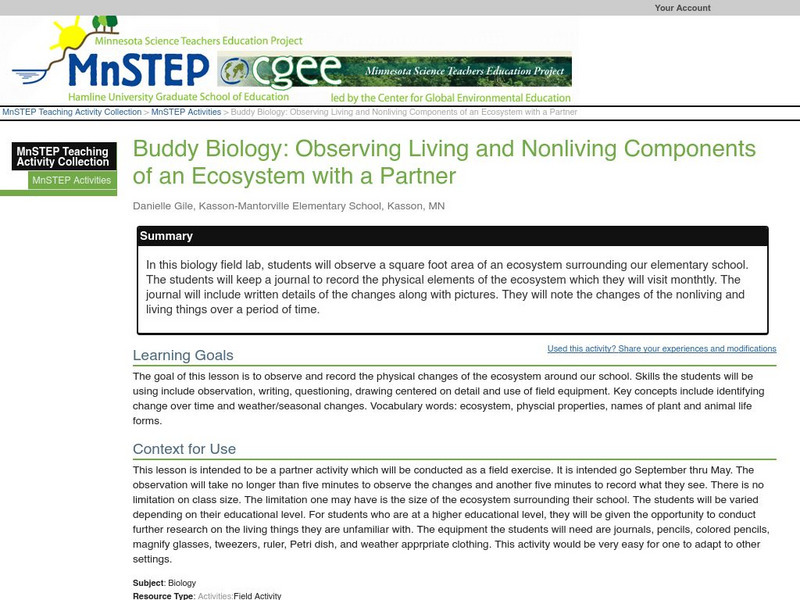Hi, what do you want to do?
Other
Science4 Us: Living/nonliving
Students explore the similarities and differences between living and nonliving things and learn four characteristics that all living things share (they have needs, they are made up of parts, they respond to change, they reproduce)....
Utah Education Network
Uen: Are You Among the Living or the Nonliving?
Great site to test your knowledge on living and nonliving things. Play a game that tests your knowledge, and view pictures to pick out each living organism.
Science Education Resource Center at Carleton College
Serc: Observing Living and Nonliving Components of an Ecosystem With a Partner
In this biology field lab, students will observe a square foot area of an ecosystem surrounding our elementary school. The students will keep a journal to record the physical elements of the ecosystem which they will visit monthtly. The...
Utah Education Network
Uen: Looking at the Community Tree
A neighborhood tree is observed for evidence of interactions between living and nonliving things.
Utah Education Network
Uen: Trb 3:2 Investigation 3 Terrariums / Aquariums
Creating aquariums/terrariums help students understand how creatures depend on living and nonliving things.
Utah Education Network
Uen: Mini Ecosystems
Third graders will make small-scale environments and will describe interactions between living and nonliving things in their environments.
SMART Technologies
Smart: Living and Nonliving Things
Students define the characteristics of living and non-living things, identify living and non-living components of an ecosystem, and identify the roles of organisms in living systems.
ClassFlow
Class Flow: Living and Nonliving
[Free Registration/Login Required] Flipchart details characteristics of living and nonliving things, then asks students to classify. Activote questions are included.
Other
Vida: Living and Non Living Things
Study these four images when learning about living and nonliving things.
Utah Education Network
Uen: What It Is, What It Isn't
Recognize characteristics of living and nonliving items within an environment.
Alabama Learning Exchange
Alex: Wanted Dead or Alive!
In this lesson students will identify the characteristics of living and nonliving things.
E-learning for Kids
E Learning for Kids: Science: Marshall Islands: How Can We Tell Living Things From Non Living Things?
Andrea lives on the Marshall Islands, and she will teach you about living and nonliving things.
BiologyWise
Biology Wise: Comparison of Living and Non Living Things
Compares the characteristics of living and non-living things based on respiration, life processes, response to stimuli, death, and composition.
eSchool Today
E School Today: Your Revision Notes on the Characteristics of Living Things
Discusses the five characteristics that living things have and nonliving things do not.
CK-12 Foundation
Ck 12: Life Science: 12.10 Ecosystems
See how living and nonliving things exist together in an ecosystem.
E-learning for Kids
E Learning for Kids: Science: Scotland: How Can We Group Living Things Based on Characteristics?
Lilly is from Peru, and she's traveling the world. Right now, she's in Scotland. Join her while she studies living and non-living things.
Utah Education Network
Uen: What's Different About These Worms?
Observe three different worm models and identify characteristics.
CPALMS
Florida State University Cpalms: Florida Students: Atoms Make Up Everything
Learn how atoms are the building blocks of all living and nonliving things.
Alabama Learning Exchange
Alex: From Weeds to Worms
The purpose of this lesson is to guide students in researching and discovering the importance of the interdependence of living and nonliving things in an ecosystem. Students utilize technology independently and cooperatively to establish...
ClassFlow
Class Flow: Understanding Ecosystems
[Free Registration/Login Required] This flipchart will help students to learn about ecosystems and the living and nonliving things that interact in them.
PBS
Nh Pbs: Nature Works: Ecosystems
How would you define an ecosystem? Check out this educational resource to learn more about the living and nonliving parts of different ecosystems.
OpenSciEd
Open Sci Ed: 7.4 Matter Cycling & Photosynthesis
Where does food come from and where does it go next? This unit helps students figure out that they can trace all food back to plants, including processed and synthetic food. They obtain and communicate information to explain how matter...
E-learning for Kids
E Learning for Kids: Science: Scotland: How Can We Group Non Living Things Based on Characteristics/purposes?
Montgomery is a true Scot, and even wears a kilt. He works in his dad's store and needs help learning about materials.
Khan Academy
Khan Academy: Activity: Claim Testing What Is Life?
In this claim-testing exercise, you're going to make determinations about whether or not claims about living versus nonliving things are true or false.



















